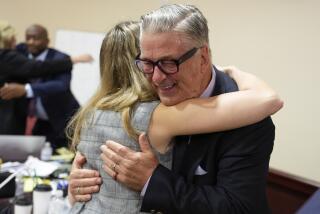Slew of Defense Witnesses Target Murder Timeline : Simpson trial: They say they heard no barking at key time. Prosecutors aggressively cross-examine them.
Racing through witnesses in an attempt to project confidence, O.J. Simpson’s defense team presented testimony Tuesday intended to demonstrate their client’s good nature and to poke holes in the prosecution’s theory of when the murders were committed.
The defense called eight witnesses to the stand Tuesday, most of them to testify that they had not heard barking or wailing dogs at the time that prosecutors contend that Nicole Brown Simpson and Ronald Lyle Goldman were being killed. And near the day’s conclusion, Simpson attorney Johnnie L. Cochran Jr. questioned Brentwood resident Robert Heidstra, who told the jury that he had heard what he took to be two men arguing near the crime scene.
One exclaimed “Hey, hey, hey!” Heidstra said. The other responded, but his words were inaudible, drowned out by two loudly barking dogs, said the witness, who will face cross-examination today.
Barking was a theme for the day, as the defense sought to show that Nicole Simpson’s dog--an Akita named Kato--had not begun wailing until long after prosecutors say the murders were carried out.
Danny Mandel, a Sony Pictures employee who was on a blind date the night of the killings, testified that he and his date, Ellen Aaronson, walked by the scene of the murders shortly after 10:20 p.m. and neither saw blood nor heard a barking dog.
Mandel’s testimony, which was seconded by Aaronson, raised questions about a central aspect of the prosecution case: the government’s contention that the time of the killings can be established by the wailing and barking of Nicole Simpson’s dog, which prosecution witnesses set at shortly after 10:15 p.m.
Additional questions about the barking involved several other witnesses, most pointedly from Denise Pilnak, who lives in the neighborhood where the murders were committed and who said she did not hear any barking until 10:33 p.m. or 10:35 p.m. Pilnak’s account was bolstered by her self-professed careful habits and attentive devotion to time.
“I am a stickler for time,” Pilnak said. “I don’t go anywhere without two watches when it’s important.”
With that, Pilnak pulled up the left sleeve on her black-and-white blazer and showed the jury her two watches, one a gold dress watch and the other a plastic digital model. Pilnak’s testimony was at least partly undercut, however, when Deputy Dist. Atty. Marcia Clark confronted her with interviews in which she told police and reporters that she had heard barking shortly before midnight--statements Pilnak downplayed by saying that she was still in shock when she made them.
Timing is an essential issue in the case against Simpson, who has pleaded not guilty to the June 12, 1994, murders. Simpson’s whereabouts are not accounted for from about 9:35 p.m. to about 10:55 p.m., when a limousine driver met him at his house to take him to the airport. But prosecutors contend that the defendant, who was late meeting that limousine, had time to commit the killings and still rush home to catch the car.
Responding to the defense testimony Tuesday, Clark waged a string of aggressive cross-examinations, battering the witnesses with questions intended to shake the jury’s confidence in their time estimates. In addition, Clark tried to pit the witnesses against each other, questioning how so many of them could have seen the comings and goings on the street that evening and not have seen each other.
Mandel and Aaronson stood firmly by their stories, and jurors seemed to take note of their recollections. At least 10 of the 14 panelists logged parts of Aaronson’s testimony when the young woman, who works for a company producing children’s television shows, relayed details of her evening with Mandel.
Pilnak and a friend, Judy Telander, were less successful at withstanding the pointed questioning.
Pilnak winced when Clark suggested that she was embellishing her testimony and flashed a pained grin at the jury when the prosecutor continued to bear down on her. And Telander was forced to acknowledge that a minute-by-minute log that Pilnak kept of the day’s events was flawed in at least one detail: Despite Pilnak’s ostensible attention to detail, she recorded the wrong name of the restaurant where the two had eaten dinner.
Simpson, who was smiling and engaged by the testimony of his relatives--a set of accounts that continued with his oldest sister on the stand Tuesday--followed the questioning with interest but less evident emotion. He consulted frequently with his attorneys and stared at a computer screen in front of him as exhibits were displayed, but he did not meet the witnesses with the warm eye contact that he exchanged with his daughter, mother and sisters.
Nevertheless, the testimony offered by some of Tuesday’s witnesses could prove far more important to Simpson’s defense than the loving tributes from family members. The accounts from Aaronson and Mandel were especially valuable to the defense because they were delivered firmly and came from two people with no connection to the defendant, a point that Simpson’s lawyers emphasized in their questioning.
In trying to bolster its contention that authorities were guilty of a “rush to judgment “ against Simpson, the defense also had several of its witnesses affirm that the prosecution had not called them to the stand after they gave accounts that cast doubt on the time of the murders.
No Barking
As he neared the end of his questioning, Shapiro posed a series of questions intended to drive home the central point of Mandel’s testimony.
“How sure are you that there was not a dog barking?” Shapiro asked.
“I have no recollection of one, so I’m certain,” Mandel answered.
“How certain are you that there was not a dog wailing?” Shapiro continued.
“I’m certain,” he responded.
“How certain that there was not a dog in the area?” the attorney asked.
“I’m certain,” Mandel said.
“Is there any reason why you would come and in any way shade the truth to this jury?” Shapiro concluded.
“No,” he said.
If anything, Aaronson was even more solid in her testimony. Where Mandel had wavered on some times and on the precise route the two took to the restaurant, Aaronson answered virtually every question posed to her clearly and without hesitation.
Moreover, her bottom line was exactly the same as Mandel’s: She said she had never seen any bloody paw prints, never heard a plaintively wailing dog and never heard any barking at any point that evening.
And where Mandel conceded that he was not paying much attention to the houses he passed because he was making conversation with a woman he was meeting that night for the first time, Aaronson laughingly indicated that while the two had a nice evening, their date did not have much significance for her. After their first date, the two never went out socially again--a circumstance that provided a running gag in the day’s proceedings.
Asked about what she was wearing that night, Aaronson provided a detailed description of her clothing, down to the stripes on her jacket. Clark then asked her what Mandel was wearing: “I have no idea,” she responded crisply, drawing laughter from the audience.
Mandel, who waited outside the courtroom after he testified, later told reporters that he and Aaronson just had not hit it off.
“It wasn’t a love connection,” he said.
Simpson’s Demeanor
The testimony of Aaronson and Mandel marked the first defense evidence on the question of the prosecution timeline, and came after defense lawyers presented a slew of family members and others to comment on Simpson’s demeanor in the days before and after the murders.
Tuesday, defense attorneys presented an executive who golfed with Simpson four days before the killings and who said the defendant was affable and at ease--testimony that tracked the observations of Carol Connors, a woman who saw Simpson and his girlfriend the night before the murders and who said they seemed comfortable and romantic together.
Connors’ testimony was offered both to show that Simpson did not seem distraught on the evening before the killings and also to suggest that he and Paula Barbieri were romantically linked, thus rebutting the allegation that he was obsessed with his ex-wife, as prosecutors have alleged.
Similar testimony came from members of Simpson’s family. His mother, sister and daughter testified Monday, and his oldest sister, Shirley Baker, took the stand at the beginning of Tuesday’s session.
Like the other Simpson family members, Baker described the Simpson home on the evening after the killings as a grim, stunned place, and said her brother appeared devastated by his ex-wife’s death.
“He was devastated,” Baker said. “He was crying. He was sad. He was in disbelief.”
Likewise, she said, other family members were reeling from the news of Nicole Simpson’s death.
“Nicole had been a part of our family for 17 years,” Baker said. “We couldn’t believe what was going on and we didn’t know what was going on because we were only hearing bits and pieces from the newspaper and the TV.”
Simpson’s distress on the day after the murders was contrasted Tuesday with a description of him as gregarious and upbeat a few days earlier, when he participated in a golf tournament in Virginia. That description came from Jack McKay, the chief financial officer of the American Psychological Assn., who said he enjoyed playing golf with Simpson, a cheerful celebrity who “didn’t put on airs.”
Clark, who had kept her temper in check during the delicate questioning of Simpson’s relatives, attacked McKay’s testimony with a vigor that seemed to take the witness by surprise. She suggested that Simpson’s cheerful demeanor could be attributed to the fact that McKay’s organization was a Hertz client and that Simpson was at the golf tournament as a Hertz representative.
Driving her point home, Clark asked McKay whether he would expect a spokesman to portray his firm in a positive light.
“If they expect to keep their job, yes,” McKay acknowledged.
Clark on the Attack
Through their sharp questioning, prosecutors conveyed their utter disbelief for the accounts given by the defense’s timeline witnesses.
The shift in tone was abrupt and striking. Some members of the courtroom audience stiffened as Clark’s voice took on a hard edge in questioning McKay. And as the day progressed, she kept up the barrage.
“There is an open question of how the jury will react,” said Paul F. Rothstein, Georgetown law professor.
Clark, he said, “ran the risk of looking like she was browbeating a witness who was just doing her civic duty and had no ax to grind. It was just the opposite of how she treated the family members--very sweetly.”
But Clark’s direct and confrontational style yielded a number of admissions from defense witnesses. Mandel, for instance, acknowledged that he was not paying close attention to his surroundings as he and Aaronson walked home from dinner.
“Were you looking up each pathway to see what was at the end of each pathway?” the prosecutor asked him, her voice hard.
“I was not,” Mandel responded.
Similarly, Deputy Dist. Atty. Christopher A. Darden elicited the admission from Francesca Harman that although she drove by the murder scene at 10:20 p.m., her headlights did not pick up the front gate of Nicole Simpson’s condominium and her radio was on, possibly preventing her from hearing a barking dog.
The prosecution’s biggest gains came with Pilnak, who prepared a painstaking log of times from that night--a log that Clark referred to disparagingly as a “script.” Pilnak conceded under direct examination that she had initially given incorrect times to a police officer when interviewed June 13, the day after the murders. She attributed those mistakes to her shock at learning of the killings.
But Clark pointed out to her that she had repeated those times when interviewed by reporters the following day as well.
“Were you still in shock on June the 14th?” Clark asked sarcastically.
“I guess so,” Pilnak responded.
After questioning Pilnak for about an hour, Clark reminded the witness that she had told the jury about being a stickler for time and that she always wore two watches when time was important to her.
“Do you recall actually how long you’ve been here today?” Clark asked.
“I arrived about 10:15, 10:30,” Pilnak responded.
“And you are wearing two watches?” the prosecutor continued.
“Well,” Pilnak said, pausing, “my first watch wasn’t working real well so I just wanted to make sure with time.”
“So was it 10:15 or was it 10:30?” Clark asked.
“I didn’t look at what time I arrived today.” Pilnak responded.
After a brief exchange, Clark continued: “Is it not a big event, Ms. Pilnak, for you to come to court today?”
“It is a big event but . . . “ the witness began haltingly.
“Not something you do every day, is it?” Clark asked. Cochran objected, asking Ito to prevent the prosecutor from interrupting Pilnak’s answer.
Rather than pose the question again, Clark turned back to her desk and said dismissively: “I have nothing further.”
Although some observers recoiled at Clark’s tone in questioning some of the early witnesses Tuesday, her handling of Pilnak won plaudits from legal analysts, including some who have often criticized the prosecution.
Clark’s cross-examination of Pilnak was “a knockout punch and I think she took Hansel and Gretel with her,” said Santa Monica defense attorney Gigi Gordon, referring to Mandel and Aaronson.
“Pilnak’s testimony is inconsistent with her earlier statements,” Gordon said. “She claims to be fanatical about time, and the time in her written statement [to police] was off by an hour, and the reason she gave--that she was in shock--is preposterous.”
The Simpson defense, which is moving along at a galloping pace, resumes this morning with another batch of witnesses. Thirteen have testified in two days.
The speedy handling of witnesses partly reflects a defense belief that jurors will appreciate the faster pace. Outside court, Cochran said the testimony will continue to unfold quickly.
“I’ve already broken the record with six witnesses in a day, and we’re going for eight today,” he said during a break near the end of the day. “We’re moving this case.”
Times legal affairs writer Henry Weinstein also contributed to this story.
More to Read
Sign up for Essential California
The most important California stories and recommendations in your inbox every morning.
You may occasionally receive promotional content from the Los Angeles Times.












